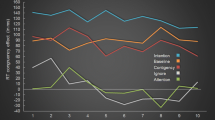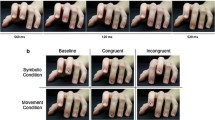Abstract
In adults, the selection and the planning of actions are influenced by the anticipation of desired action effects. However, the role of action effects for action control in infants is still an unresolved issue. One important prerequisite for infants’ action control is that infants are able to relate certain movements to certain effects. To test this assumption, it was investigated how infants’ action control is affected by action effects. By applying an imitation paradigm, we studied 12- and 18-month-old infants who first observed an adult experimenter demonstrating a three-step action sequence on a toy bear. In three experimental groups, the second action step, the third action step, or no action step elicited an arbitrary sound as an additional acoustic action effect. It was coded how often each of the target actions was performed by the infant in a subsequent 90-s test phase. As predicted, the frequency of the infant’s target action varied depending on which action step elicited the action effect. In both age groups, the target action that was combined with an acoustical effect was not only produced more often but also occurred with lower latency and was in most cases the first target action shown by the infants. These results are interpreted as evidence of the important role of action effects in infants’ action control.





Similar content being viewed by others
References
Aschersleben, G., & Prinz, W. (1995). Synchronizing actions with events: The role of sensory information. Perception & Psychophysics, 57, 305–317.
Aschersleben, G., Stenneken, P., Cole, J., & Prinz, W. (2002). Timing mechanism in sensorimotor synchronization. In W. Prinz & B. Hommel (Eds.), Common mechanisms in perception and action: Attention and performance, Vol. XIX. (pp. 227–244). Oxford: Oxford University Press.
Baldwin, D. A., & Baird, J. A. (1999). Action analysis: A gateway to intentional inference. In P. Rochat (Ed.), Early social cognition: Understanding others in the first months of life (pp. 215–240). Mahwah, NJ: Lawrence Erlbaum.
Baldwin, D., Baird, J., Saylor, M. M., & Clark, M. A. (2001). Infants parse dynamic action. Child Development, 72, 708–717.
Barr, R., & Hayne, H. (1996). The effect of event structure on imitation in infancy: Practice makes perfect? Infant Behavior & Development, 19, 253–257.
Barr, R., Dowden, A., & Hayne, H. (1996). Developmental changes in deferred imitation by 6- to 24-month-old infants. Infant Behavior and Development, 19, 159–170.
Bayley, N. (1993). Bayley scales of infant development, 2nd edition. New York: Psychological Corporation.
Csibra, G., Gergely, G., Biro, S., Koos, O., & Brockbank, M. (1999). Goal attribution without agency cues: The perception of “pure reason” in infancy. Cognition, 72, 237–267.
DeCasper, A. J., & Fifer, W. P. (1980) Of human bonding: Newborns prefer their mothers’ voices. Science, 208, 1174–1176.
Drewing, K., & Aschersleben, G. (2003). Reduced timing variability during bimanual coupling: a role for sensory information. The Quarterly Journal of Experimental Psychology, 56A, 329–350.
Elsner, B., & Aschersleben, G. (2003). Infants’ imitation of action sequences: Not only a memory problem! Paper presented at the Biennial Meeting of the Society for Research in Child Development, Tampa, USA, April 2003.
Elsner, B., & Aschersleben, G. (in press). Do I get what you get? Learning about effects of self-performed and observed actions in infants. Consciousness and Cognition.
Elsner, B., & Hommel, B. (2001). Effect anticipation and action control. Journal of Experimental Psychology: Human Perception and Performance, 27, 229–240.
Eskritt, M., Donald, M., & Muir, D. W. (1998). Delayed imitation of complex behavioural sequences by 14- to 16-month olds. Early Development & Parenting, 7, 171–180.
Hommel, B. (1996). The cognitive representation of action: Automatic integration of perceived action effects. Psychological Research, 59, 176–186.
Hommel, B., Müsseler, J., Aschersleben, G. & Prinz, W. (2001). The theory of event coding: a framework for perception and action planning. Behavioral and Brain Sciences, 24, 849–937.
James, W. (1890/1981). The principles of psychology. Cambridge, MA: Harvard University Press.
Jeannerod, M. (1994). The representing brain—neural correlates of motor intention and imagery. Behavioral and Brain Sciences, 17, 187–202.
Jovanovic, B. (2002). The development of self and intentional understanding in infancy. Unpublished doctoral thesis. Max-Planck-Institute for Psychological Research, Munich.
Jovanovic, B., Király, I., Elsner, B., Gergely, G., Prinz, W., & Aschersleben, G. (2003). The role of effects for infants’ perception of action goals. Manuscript submitted for publication.
Knoblich, G., & Flach, R. (2001). Predicting the effects of actions: Interactions of perception and action. Psychological Science, 12, 467–472.
Kunde, W. (2001). Response-effect compatibility in manual choice reaction tasks. Journal of Experimental Psychology: Human Perception and Performance, 27, 387–394.
Leslie, A. (1984). Infants’ perception of a manual pick up event. British Journal of Developmental Psychology, 2, 19–32.
Meltzoff, A. N. (1988). Infant imitation and memory: Nine-month-olds in immediate and deferred tests. Child Development, 59, 217–225.
Meltzoff, A. N. (2002). Elements of a developmental theory of imitation. In A. N. Meltzoff & W. Prinz (Eds.), The imitative mind: Development, evolution, and brain bases (pp. 19–41). Cambridge, MA: MIT Press.
Müsseler, J., & Wühr, P. (2002). Response-evoked interference in visual encoding. In W. Prinz & B. Hommel (Eds.), Common mechanisms in perception and action: Attention and Performance, Vol. XIX (pp. 520–537). Oxford: Oxford University Press.
Papousek, H. (1967). Experimental studies of appetitional behavior in human newborns and infants. In H. W. Stevenson, E. H. Hess, & H. L. Rheingold (Eds.), Early behavior: Comparative and developmental approaches (pp. 249–277). New York, NY: Wiley.
Piaget, J. (1952). The origins of intelligence. New York: Basic Books.
Prinz, W. (1990). A common coding approach to perception and action. In O. Neumann & W. Prinz (Eds.), Relationships between perception and action: Current approaches (pp. 167–201). Berlin Heidelberber New York: Springer.
Prinz, W. (1997). Perception and action planning. European Journal of Cognitive Psychology, 9, 129–154.
Rochat, P., & Morgan, R. (1998). Two functional orientations of self-exploration in infancy. British Journal of Developmental Psychology, 16, 139–154.
Rosenbaum, D. A., & Krist, H. (1996). Antecedents of action. In H. Heuer (Ed.), Handbook of perception and action, Vol. 2: Motor skills (pp. 3–69). San Diego, CA: Academic Press.
Rovee, C. K., & Rovee, D. T. (1969). Conjugate reinforcement of infants’ exploratory behavior. Journal of Experimental Child Psychology, 8, 33–39.
Rovee-Collier, C. (1987). Learning and memory in infancy. In J. D. Osofsky (Ed.), Handbook of infant development (2nd ed., pp. 98–148). New York, NY: Wiley.
Rovee-Collier, C., & Shyi, G. (1993). A functional and cognitive analysis of infant long-term retention. In M. L. Howe, C. J. Brainerd, & V. F. Reyna (Eds.), Development of long-term retention. New York Berlin Heidelberg: Springer.
Tomasello, M. (1999). The cultural origins of human cognition. Cambridge, MA: Harvard University Press.
Uzgiris, I. C., & Hunt, J. M. (1975). Assessment in infancy: Ordinal scales of psychological development. Chicago, IL: University of Illinois Press.
Willatts, P. (1999). Development of means-end behavior in young infants: pulling a support to retrieve a distant object. Developmental Psychology, 35, 3, 651–666.
Woodward, A. L. (1998). Infants selectively encode the goal object of an actor’s reach. Cognition, 69, 1–34.
Woodward, A. L. (1999). Infant’s ability to distinguish between purposeful and non-purposeful behaviors. Infant Behavior and Development, 22, 145–160.
Zacks, J. M., Tversky, B., & Iyer, G. (2001). Perceiving, remembering, and communicating structure in events. Journal of Experimental Psychology: General, 130, 29–58.
Zießler, M., & Nattkemper, D. (2002). Effect anticipation in action planning. In W. Prinz & B. Hommel (Eds.), Common mechanisms in perception and action: Attention and performance, Vol. XIX (pp. 645–672). Oxford: Oxford University Press.
Acknowledgements
The authors express their gratitude to the parents and infants who participated in this study. We wish to thank Michael Zießler, Dieter Nattkemper, and two anonymous reviewers for their helpful criticism, suggestions, and comments on an earlier draft. We also wish to thank Maria Zumbeel for acquisition of the participants as well as Vera Blau and Monika Kleppe for help in data collection and scoring the videotapes.
Author information
Authors and Affiliations
Corresponding author
Rights and permissions
About this article
Cite this article
Hauf, P., Elsner, B. & Aschersleben, G. The role of action effects in infants’ action control. Psychological Research 68, 115–125 (2004). https://doi.org/10.1007/s00426-003-0149-2
Accepted:
Published:
Issue Date:
DOI: https://doi.org/10.1007/s00426-003-0149-2




